I got task to improve existing code / query from my company,
Database version
Oracle Database 10g Enterprise Edition Release 10.2.0.4.0 - 64bi
PL/SQL Release 10.2.0.4.0 - Production
"CORE 10.2.0.4.0 Production"
TNS for IBM/AIX RISC System/6000: Version 10.2.0.4.0 - Productio
NLSRTL Version 10.2.0.4.0 - Production
Here's the problem- when below code is executed, the time taken to finish the job is more than 4 hours, something around 7 to 8 hours.

395 row data within 3 hours 37 minutes
SELECT DISTINCT GROUP_DIST_NUMBER, BEGIN_DATE, PRICE_DROP_DATE
FROM (SELECT DISTINCT
G.GROUP_DIST_NUMBER,
TO_DATE (:B2, 'DD-MON-YYYY') BEGIN_DATE,
TO_DATE (:B2, 'DD-MON-YYYY') PRICE_DROP_DATE
FROM POS_DISTI_GROUP G,
POS_CUST_XREF M,
S_CPT_SEQ_NO C,
PP_STD_PRICE P,
S_CPT_AUDIT A,
RPT_PRODUCT_VALUE_LEVEL L
WHERE G.END_DATE > TO_DATE (:B2, 'DD-MON-YYYY')
AND G.GROUP_DIST_NUMBER = M.DIST_NUMBER
AND M.SG_BILL_TO_CUST_NO = A.BILL_TO_CUST_NO
AND A.START_DATE <= TO_DATE (:B2, 'DD-MON-YYYY')
AND A.END_DATE >= TO_DATE (:B2, 'DD-MON-YYYY')
AND L.PROD_VALUE = P.PROD_VALUE
AND L.PROD_LEVEL = P.PROD_LEVEL
AND C.CPT_PRICE_CODE IN
(SELECT /*+ PRECOMPUTE_SUBQUERY */
DISTINCT C1.CPT_PRICE_CODE
FROM PP_STD_PRICE P1,
S_CPT_PRICE_CODE C1,
S_CPT_SEQ_NO S1
WHERE P1.STDP_ID = :B1
AND C1.CPT_PRICE_CAT LIKE 'NB%'
AND C1.CPT_PRICE_CODE = S1.CPT_PRICE_CODE
AND S1.PRICE_PROTECTABLE = 'Y')
AND C.CPT_PRICE_CODE = P.CUST_PRICE_TYPE
AND P.STDP_ID = :B1
AND A.CUST_PRICE_TYPE = C.CPT_BILL_CODE
AND M.ACTIVE_IND != 'N'
AND (M.CATEGORY_TYPE LIKE 'DIRECT%' OR M.INDIRECT_DISTI = 'Y')
AND TRUNC (M.ARCHIVE_DATE) > TRUNC (SYSDATE)
UNION
SELECT G.GROUP_DIST_NUMBER,
P.BEGIN_DATE,
MIN (INVT.PRICE_DROP_DATE) PRICE_DROP_DATE
FROM POS_DISTI_GROUP G,
POS_CUST_XREF M,
PP_DEBIT_AUTHORIZATION P,
RPT_PRODUCT_VALUE_LEVEL L,
POS_PP_INVENTORY INVT
WHERE G.END_DATE > TO_DATE (:B2, 'DD-MON-YYYY')
AND G.GROUP_DIST_NUMBER = M.DIST_NUMBER
AND M.ACTIVE_IND != 'N'
AND (M.CATEGORY_TYPE LIKE 'DIRECT%' OR M.INDIRECT_DISTI = 'Y')
AND G.DIST_NUMBER = P.DIST_NUMBER
AND L.PROD_VALUE = P.PROD_VALUE
AND L.PROD_LEVEL = P.PROD_LEVEL
AND P.BEGIN_DATE >= TO_DATE (:B2, 'DD-MON-YYYY') - 6
AND P.BEGIN_DATE <= TO_DATE (:B2, 'DD-MON-YYYY')
AND INVT.DIST_NUMBER = G.GROUP_DIST_NUMBER
AND INVT.STMODEL = L.MOD_DESC
AND INVT.PPCF_SHOW_DATE = P.BEGIN_DATE
AND P.PRICE_TYPE = 'I'
AND ( P.POS_PROCESSED_FLAG IS NULL
OR P.POS_PROCESSED_FLAG != 'C')
AND P.POS_PP_FLAG = 'Y'
AND TRUNC (M.ARCHIVE_DATE) > TRUNC (SYSDATE)
GROUP BY G.GROUP_DIST_NUMBER, P.BEGIN_DATE)
ORDER BY GROUP_DIST_NUMBER;
I have no idea how to tune this query statement to improve the performance and make it execute faster
here the EXPLAIN PLAN
--------------------------------------------------------------------------------------------------------------------------------------
| Id | Operation | Name | Rows | Bytes |TempSpc| Cost (%CPU)| Pstart| Pstop |
--------------------------------------------------------------------------------------------------------------------------------------
| 0 | SELECT STATEMENT | | 101 | 2525 | | 24156 (10)| | |
| 1 | SORT ORDER BY | | 101 | 2525 | | 24156 (10)| | |
| 2 | VIEW | | 101 | 2525 | | 24155 (10)| | |
| 3 | SORT UNIQUE | | 101 | 17691 | | 24155 (75)| | |
| 4 | UNION-ALL | | | | | | | |
|* 5 | HASH JOIN | | 10M| 1680M| | 6446 (5)| | |
|* 6 | TABLE ACCESS FULL | S_CPT_SEQ_NO | 651 | 5208 | | 5 (0)| | |
|* 7 | HASH JOIN | | 2383K| 379M| | 6318 (3)| | |
|* 8 | TABLE ACCESS FULL | POS_DISTI_GROUP | 100 | 1800 | | 5 (0)| | |
|* 9 | HASH JOIN | | 2396K| 340M| 4320K| 6283 (3)| | |
| 10 | VIEW | RPT_PRODUCT_VALUE_LEVEL | 138K| 2697K| | 1905 (3)| | |
| 11 | UNION-ALL | | | | | | | |
|* 12 | HASH JOIN RIGHT OUTER | | 13965 | 627K| | 91 (5)| | |
| 13 | INDEX FULL SCAN | PK_SEAEGO_PRODUCT_HIERARCHY | 298 | 4172 | | 1 (0)| | |
|* 14 | HASH JOIN RIGHT OUTER | | 13965 | 436K| | 89 (4)| | |
| 15 | INDEX FULL SCAN | PK_S_CAP_GROUP | 2 | 8 | | 1 (0)| | |
| 16 | TABLE ACCESS FULL | SMA_STMODEL | 13965 | 381K| | 87 (3)| | |
|* 17 | HASH JOIN RIGHT OUTER | | 14175 | 1065K| | 158 (5)| | |
| 18 | INDEX FAST FULL SCAN | PK_S_FAMILY | 1366 | 5464 | | 2 (0)| | |
|* 19 | HASH JOIN RIGHT OUTER | | 14175 | 1010K| | 156 (5)| | |
| 20 | INDEX FULL SCAN | PK_F_MODPRODMGR | 22 | 88 | | 1 (0)| | |
|* 21 | HASH JOIN | | 14175 | 955K| | 154 (4)| | |
| 22 | TABLE ACCESS FULL | SMA_PRODUCTMODEL | 14132 | 317K| | 62 (2)| | |
|* 23 | HASH JOIN RIGHT OUTER | | 13965 | 627K| | 91 (5)| | |
| 24 | INDEX FULL SCAN | PK_SEAEGO_PRODUCT_HIERARCHY | 298 | 4172 | | 1 (0)| | |
|* 25 | HASH JOIN RIGHT OUTER | | 13965 | 436K| | 89 (4)| | |
| 26 | INDEX FULL SCAN | PK_S_CAP_GROUP | 2 | 8 | | 1 (0)| | |
| 27 | TABLE ACCESS FULL | SMA_STMODEL | 13965 | 381K| | 87 (3)| | |
| 28 | MAT_VIEW ACCESS FULL | RPT_PROD_MV | 109K| 1288K| | 1656 (3)| | |
|* 29 | HASH JOIN | | 141K| 17M| | 3191 (3)| | |
|* 30 | INDEX RANGE SCAN | UK_PP_STD_PRICE_STDP_ID | 4128 | 108K| | 23 (0)| | |
|* 31 | HASH JOIN | | 5341 | 532K| | 3165 (3)| | |
|* 32 | TABLE ACCESS FULL | POS_CUST_XREF | 54 | 2268 | | 25 (4)| | |
|* 33 | HASH JOIN | | 193K| 11M| | 3137 (3)| | |
|* 34 | TABLE ACCESS FULL | S_CPT_AUDIT | 68 | 2108 | | 76 (4)| | |
|* 35 | HASH JOIN | | 745K| 20M| | 3052 (2)| | |
| 36 | TABLE ACCESS FULL | S_CPT_SEQ_NO | 1301 | 16913 | | 5 (0)| | |
| 37 | MERGE JOIN CARTESIAN | | 88205 | 1378K| | 3037 (2)| | |
|* 38 | INDEX RANGE SCAN | UK_PP_STD_PRICE_STDP_ID | 4128 | 20640 | | 23 (0)| | |
| 39 | BUFFER SORT | | 21 | 231 | | 3014 (2)| | |
|* 40 | TABLE ACCESS FULL | S_CPT_PRICE_CODE | 21 | 231 | | 1 (0)| | |
| 41 | HASH GROUP BY | | 1 | 191 | | 16421 (5)| | |
|* 42 | FILTER | | | | | | | |
| 43 | NESTED LOOPS | | 1 | 191 | | 16419 (5)| | |
|* 44 | HASH JOIN | | 7 | 1176 | | 16370 (5)| | |
|* 45 | HASH JOIN | | 74 | 8584 | | 4790 (3)| | |
|* 46 | HASH JOIN | | 60 | 3780 | | 31 (7)| | |
|* 47 | TABLE ACCESS FULL | POS_CUST_XREF | 60 | 2100 | | 25 (4)| | |
|* 48 | TABLE ACCESS FULL | POS_DISTI_GROUP | 100 | 2800 | | 5 (0)| | |
|* 49 | TABLE ACCESS FULL | PP_DEBIT_AUTHORIZATION | 345 | 18285 | | 4759 (3)| | |
| 50 | PARTITION RANGE ALL | | 18192 | 923K| | 11579 (6)| 1 | 33 |
|* 51 | INDEX FAST FULL SCAN | POS_PP_INVENTORY_PK | 18192 | 923K| | 11579 (6)| 1 | 33 |
|* 52 | VIEW | RPT_PRODUCT_VALUE_LEVEL | 1 | 23 | | 7 (0)| | |
| 53 | UNION ALL PUSHED PREDICATE | | | | | | | |
|* 54 | FILTER | | | | | | | |
| 55 | NESTED LOOPS OUTER | | 1 | 46 | | 2 (0)| | |
| 56 | NESTED LOOPS OUTER | | 1 | 42 | | 2 (0)| | |
| 57 | TABLE ACCESS BY INDEX ROWID | SMA_STMODEL | 1 | 28 | | 2 (0)| | |
|* 58 | INDEX UNIQUE SCAN | PK_SMA_STMODEL | 1 | | | 1 (0)| | |
|* 59 | INDEX UNIQUE SCAN | PK_SEAEGO_PRODUCT_HIERARCHY | 298 | 4172 | | 0 (0)| | |
|* 60 | INDEX UNIQUE SCAN | PK_S_CAP_GROUP | 2 | 8 | | 0 (0)| | |
| 61 | NESTED LOOPS OUTER | | 1 | 77 | | 3 (0)| | |
| 62 | NESTED LOOPS OUTER | | 1 | 73 | | 3 (0)| | |
| 63 | NESTED LOOPS OUTER | | 1 | 69 | | 3 (0)| | |
| 64 | NESTED LOOPS OUTER | | 1 | 65 | | 3 (0)| | |
| 65 | NESTED LOOPS | | 1 | 51 | | 3 (0)| | |
|* 66 | TABLE ACCESS BY INDEX ROWID| SMA_PRODUCTMODEL | 1 | 23 | | 2 (0)| | |
|* 67 | INDEX UNIQUE SCAN | PK_SMA_PRODUCTMODEL | 1 | | | 1 (0)| | |
| 68 | TABLE ACCESS BY INDEX ROWID| SMA_STMODEL | 1 | 28 | | 1 (0)| | |
|* 69 | INDEX UNIQUE SCAN | PK_SMA_STMODEL | 1 | | | 0 (0)| | |
|* 70 | INDEX UNIQUE SCAN | PK_SEAEGO_PRODUCT_HIERARCHY | 298 | 4172 | | 0 (0)| | |
|* 71 | INDEX UNIQUE SCAN | PK_S_FAMILY | 1366 | 5464 | | 0 (0)| | |
|* 72 | INDEX UNIQUE SCAN | PK_S_CAP_GROUP | 2 | 8 | | 0 (0)| | |
|* 73 | INDEX UNIQUE SCAN | PK_F_MODPRODMGR | 22 | 88 | | 0 (0)| | |
|* 74 | MAT_VIEW ACCESS BY INDEX ROWID | RPT_PROD_MV | 1 | 24 | | 2 (0)| | |
|* 75 | INDEX UNIQUE SCAN | IDX_RPT_PROD_MV_PROD_NO | 1 | | | 1 (0)| | |
--------------------------------------------------------------------------------------------------------------------------------------
Predicate Information (identified by operation id):
---------------------------------------------------
5 - access("C1"."CPT_PRICE_CODE"="S1"."CPT_PRICE_CODE")
6 - filter("S1"."PRICE_PROTECTABLE"='Y')
7 - access("G"."GROUP_DIST_NUMBER"="M"."DIST_NUMBER")
8 - filter("G"."END_DATE">TO_DATE(:B2,'DD-MON-YYYY'))
9 - access("L"."PROD_VALUE"="P"."PROD_VALUE" AND "L"."PROD_LEVEL"="P"."PROD_LEVEL")
12 - access("ST"."MARKETING_NAME"="PH"."MARKETING_NAME"(+))
14 - access("ST"."MOD_CAPACITY_FORMATTED"="SCG"."MOD_CAPACITY_FORMATTED"(+))
17 - access("SF"."FAMILY"(+)=SUBSTRB("PM"."MODEL",1,3))
19 - access("PM"."DESIGN_APPLICATION"="DA"."DESIGN_APPLICATION"(+))
21 - access("PM"."MOD_DESC"="ST"."MOD_DESC")
23 - access("ST"."MARKETING_NAME"="PH"."MARKETING_NAME"(+))
25 - access("ST"."MOD_CAPACITY_FORMATTED"="SCG"."MOD_CAPACITY_FORMATTED"(+))
29 - access("C"."CPT_PRICE_CODE"="P"."CUST_PRICE_TYPE")
30 - access("P"."STDP_ID"=TO_NUMBER(:B1))
31 - access("M"."SG_BILL_TO_CUST_NO"="A"."BILL_TO_CUST_NO")
32 - filter("M"."SG_BILL_TO_CUST_NO" IS NOT NULL AND ("M"."INDIRECT_DISTI"='Y' OR "M"."CATEGORY_TYPE" LIKE 'DIRECT%') AND
"M"."ACTIVE_IND"<>'N' AND TRUNC(INTERNAL_FUNCTION("M"."ARCHIVE_DATE"))>TRUNC(SYSDATE@!))
33 - access("A"."CUST_PRICE_TYPE"="C"."CPT_BILL_CODE")
34 - filter("A"."START_DATE"<=TO_DATE(:B2,'DD-MON-YYYY') AND "A"."END_DATE">=TO_DATE(:B2,'DD-MON-YYYY'))
35 - access("C"."CPT_PRICE_CODE"="C1"."CPT_PRICE_CODE")
38 - access("P1"."STDP_ID"=TO_NUMBER(:B1))
40 - filter("C1"."CPT_PRICE_CAT" LIKE 'NB%')
42 - filter(TO_DATE(:B2,'DD-MON-YYYY')-6<=TO_DATE(:B2,'DD-MON-YYYY'))
44 - access("INVT"."DIST_NUMBER"="G"."GROUP_DIST_NUMBER" AND "INVT"."PPCF_SHOW_DATE"="P"."BEGIN_DATE")
45 - access("G"."DIST_NUMBER"="P"."DIST_NUMBER")
46 - access("G"."GROUP_DIST_NUMBER"="M"."DIST_NUMBER")
47 - filter(("M"."INDIRECT_DISTI"='Y' OR "M"."CATEGORY_TYPE" LIKE 'DIRECT%') AND "M"."ACTIVE_IND"<>'N' AND
TRUNC(INTERNAL_FUNCTION("M"."ARCHIVE_DATE"))>TRUNC(SYSDATE@!))
48 - filter("G"."END_DATE">TO_DATE(:B2,'DD-MON-YYYY'))
49 - filter("P"."PRICE_TYPE"='I' AND "P"."POS_PP_FLAG"='Y' AND ("P"."POS_PROCESSED_FLAG"<>'C' OR "P"."POS_PROCESSED_FLAG"
IS NULL) AND "P"."BEGIN_DATE"<=TO_DATE(:B2,'DD-MON-YYYY') AND "P"."BEGIN_DATE">=TO_DATE(:B2,'DD-MON-YYYY')-6)
51 - filter("INVT"."PPCF_SHOW_DATE"<=TO_DATE(:B2,'DD-MON-YYYY') AND "INVT"."PPCF_SHOW_DATE">=TO_DATE(:B2,'DD-MON-YYYY')-6)
52 - filter("L"."PROD_LEVEL"="P"."PROD_LEVEL")
54 - filter("P"."PROD_VALUE"="INVT"."STMODEL")
58 - access("ST"."MOD_DESC"="P"."PROD_VALUE")
59 - access("ST"."MARKETING_NAME"="PH"."MARKETING_NAME"(+))
60 - access("ST"."MOD_CAPACITY_FORMATTED"="SCG"."MOD_CAPACITY_FORMATTED"(+))
66 - filter("PM"."MOD_DESC"="INVT"."STMODEL")
67 - access("PM"."MODEL"="P"."PROD_VALUE")
69 - access("ST"."MOD_DESC"="INVT"."STMODEL")
70 - access("ST"."MARKETING_NAME"="PH"."MARKETING_NAME"(+))
71 - access("SF"."FAMILY"(+)=SUBSTRB("PM"."MODEL",1,3))
72 - access("ST"."MOD_CAPACITY_FORMATTED"="SCG"."MOD_CAPACITY_FORMATTED"(+))
73 - access("PM"."DESIGN_APPLICATION"="DA"."DESIGN_APPLICATION"(+))
74 - filter("MOD_DESC"="INVT"."STMODEL")
75 - access("PROD_NO"="P"."PROD_VALUE")
Note
-----
- 'PLAN_TABLE' is old version
and the statistic of rows count for table
TABLE_Name NUM_ROWS
----------- ---------
POS_DISTI_GROUP 2009
POS_CUST_XREF 2801
S_CPT_SEQ_NO 1301
PP_STD_PRICE 2658450
S_CPT_AUDIT 27200
PP_DEBIT_AUTHORIZATION 1199420
POS_PP_INVENTORY 7276850
PP_STD_PRICE 2658450
S_CPT_PRICE_CODE 192
S_CPT_SEQ_NO 1301
SMA_STMODEL 13965
RPT_PROD_MV 109980
create table statement. CLICK HERE
Table Description. CLICK HERE
Retrieve EXPLAIN PLAN with rerun gather_plan_statistics as @jonearles suggest. CLICK HERE
*link from google doc


